It’s not every day you get the opportunity to be a part of Europe’s largest club festival, but over September 22-25, I traveled to Hamburg, Germany and experienced all that Reeperbahn Festival had to offer. Northern Europe’s version of South by Southwest, Reeperbahn has been going strong for 17 years, highlighting a wide variety of artists from across the European continent, and from around the world. Each year, the festival partners with another country, bringing artists from all over and press from the partner country, to see all that Hamburg has to offer.
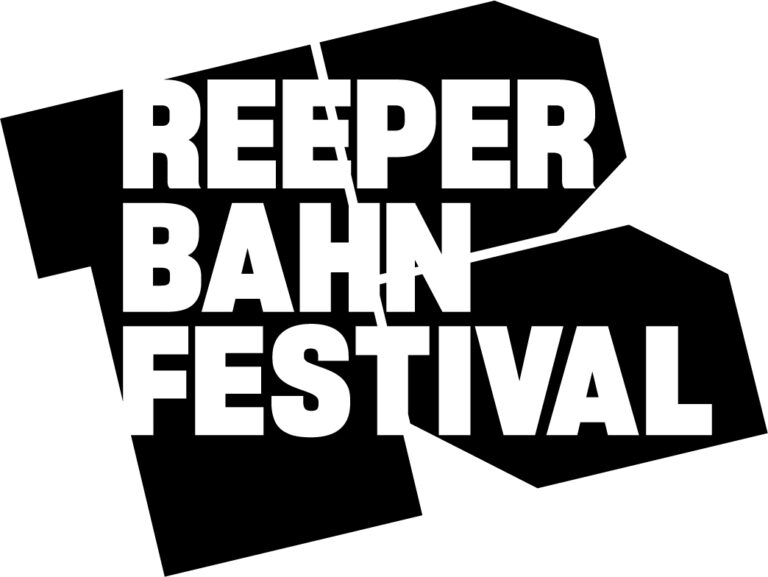
Partnering with America in the post-pandemic era meant that the ability to travel overseas had more ease and certainty of flight status than anytime in the past three years. Hamburg reached out to NYS Music for coverage of the festival, and it was an opportunity impossible to pass up.
With 24 combined hours of travel planned, and only 60 hours to spend in Hamburg seeing indie and punk bands in small club settings, the stage for the weekend was quickly set. Add in learning a bit about Hamburg and the role the city plays not just geographically, but also in music history, plus seeing performances at truly marvelous once-in-a-lifetime venues, and this whirlwind trip to a gem of a port on the North Sea made for the perfect return trip to Europe.
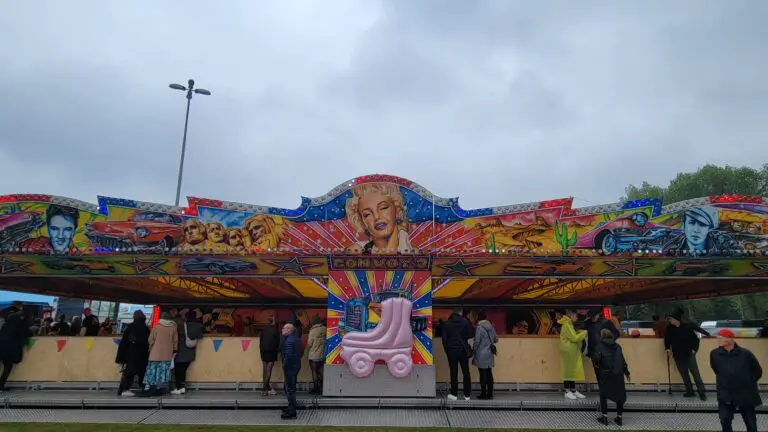
Reeperbahn is the area of Hamburg prime for entertainment and nightlife, with musicals, music venues, restaurants and a red light district that, all combined, offer a little something for everyone. ‘Ropewalk’ in English, the Reeperbahn was where rope was made, being just near the Elbe River that brings you well into the European continent or out to the North Sea, The British Isles and Scandinavia. This makes Hamburg “Das Tor zur Welt” – the Gateway to the World.
The Festival Village has its main grounds in the St. Pauli quarter of Hamburg, with a few stages, a Flatstock poster exhibit, roller skating disco, educational displays including water reclamation efforts and a few pop up band performances. Slightly underwhelming as it was – and intentionally so – the Festival Village is not a single-location music festival, but rather spread out across the Reeperbahn area at dozens of clubs and theaters, as well as outdoor stages in the median of the Reeperbahn. Flanked by the ‘dancing towers’ and the neon lights of the red light district, the nightlife was as vibrant as you’d find in Amsterdam. While not a city-wide festival, Reeperbahn gave a taste of what Hamburg has to offer, and left me wanting to return to see more of the city outside the entertainment center.
For comparison sake, take a psychedelic remix of St. Mark’s Place – multiple blocks worth – and with a paid wristband, you get to hop from club to club, seeing bands from across the country, all with the goal of finding their footing and making it to the next level.
This kind of festival of course does happen in America, with SXSW the inspiration, as co-founder and managing director Alexander Schulz shared during a dinner at Restaurant Nil with press from America, England, Denmark and Germany on Thursday evening. For an hour, Schulz entertained questions that got to the heart of why Reeperbahn is not just a notable festival for Europe, but a destination event that draws an international crowd.
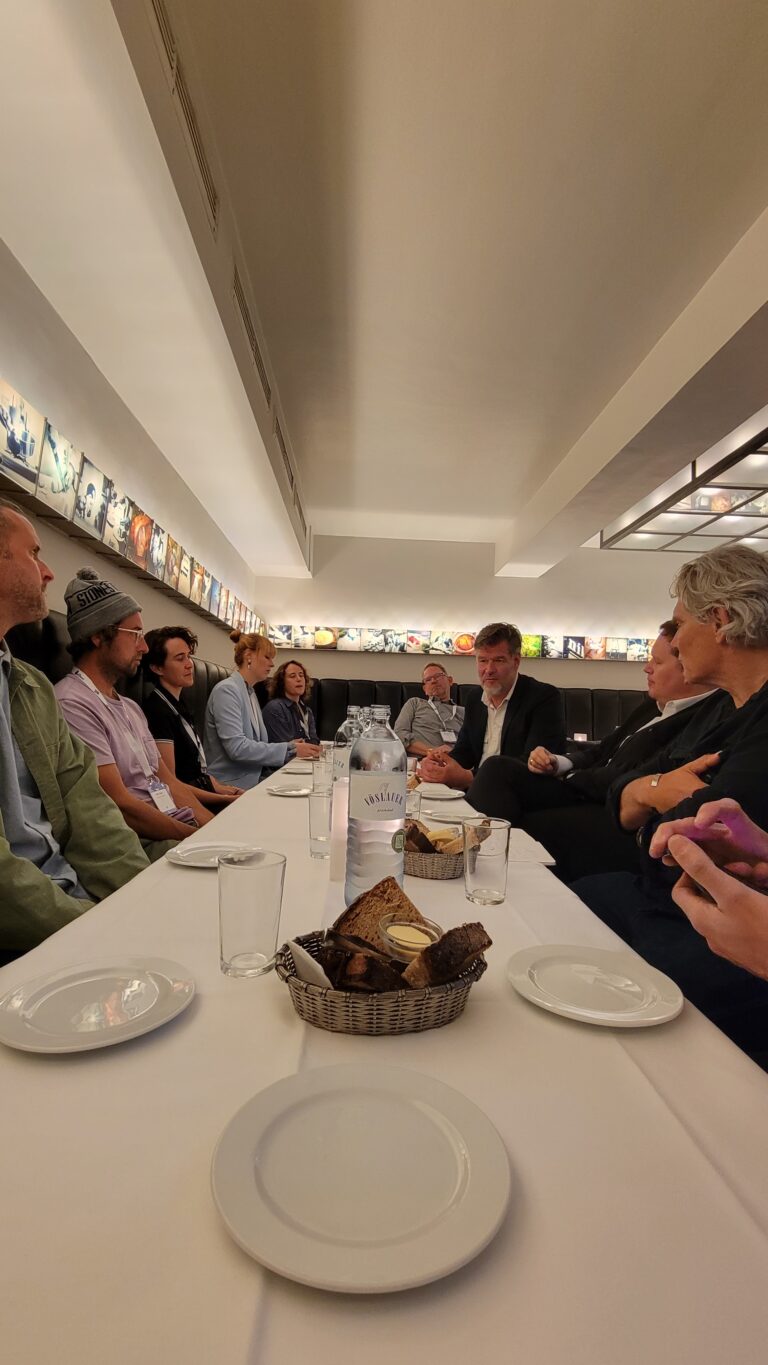
Schulz sees Reeperbahn as a way to combine a consumer program with a professional program, with both audiences meeting in the evening. Add in the Reeperbahn ANCHOR awards show on Saturday, showcasing six international finalists, and a strong relationship with the city of Hamburg, and a recipe for success is served up each September.
Navigating the pandemic by partnering in 2020 with Denmark (from which fans could drive) and in 2021 with South Korea (although the festival was mostly virtual), the first year fully back in person brought in the USA and the hope of rekindling the flame that was dimmed for a year or so.
Dr. Carsten Brosda, Minister of Culture and Media for the city of Hamburg, proudly noted that the festival is much bigger than music, and with full capacity allowed and no restrictions, it didn’t take much to get the local and regional governments behind the Reeperbahn Festival. “Whenever something is possible, we do it,” said Brosda. With hundreds working the festival plus more pre and post, the feeling of doing things together has returned, as the culture, concerts and inspiration they provided were not something the city wanted to lose. In 2020, it was the first time seeing artists on a stage all year, following months of lockdown, and some bands didn’t want to leave the stage. Skip ahead to 2021 and a second period of lockdown made it more difficult to hold the 2021 event and was thus virtual.
While global inflation certainly impacted the 2022 event, and the German government maintained a public transportation mask mandate, Reeperbahn Festival served as the gateway to European music, and connected the rest of the world via the United States. This year’s lineup of bands was meant to appeal to the musical tastes of Americans: contemporary, classic rock, techno and electronic, plus German acts that have crossover (including Hamburg duo BOY)
Following dinner, I linked up with Justin and Sam from Aquarium Drunkard, based in Los Angeles. We headed to the Reeperbahn and to Drafthaus to see Afghan-Dutch artist Ferdous, who provided a taste of futuristic R&B, the first music of this 60 hour jaunt. Making the most of the club nature of the festival, we headed over to Molotow where four venues are contained under one roof, including an outdoor ‘Backyard’, the ‘Karatekeller’, the Club and the Skybar, the latter of which we caught the soundcheck and most of the performance of Montreal band Choses Sauvages. Watching the lead singer bust out Ric Ocasek vocals (and fit the look a bit when his sunglasses were on) gave a new wave of new wave, along with animated crowd interaction that commands a second viewing in the near future on this side of the pond.
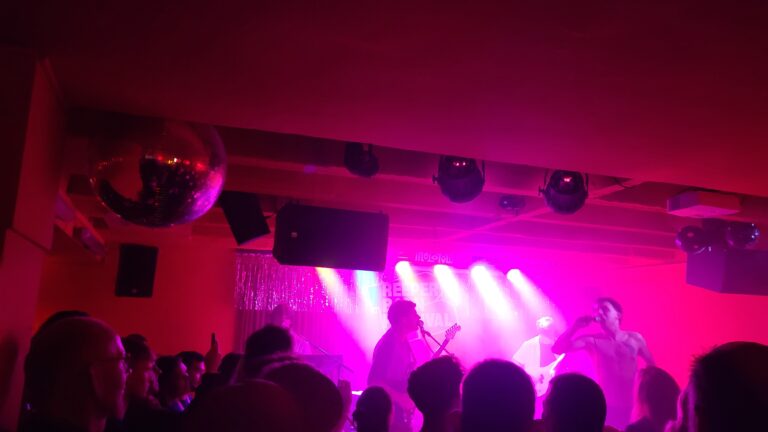
We headed to the Backyard for a brief taste of HighSchool, a post-punk trio from Melbourne, Australia. An 80s indie vibe resonated, along with a bassist who looked as though he had recently placed second in a Lou Reed look alike contest.
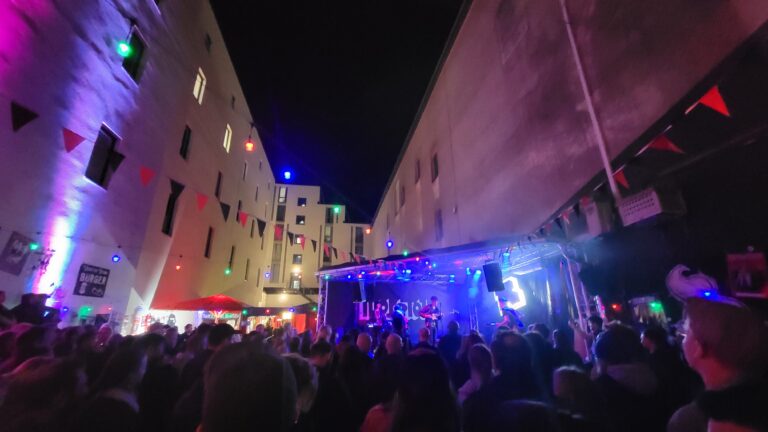
Next stop was Gruenspan – the largest stand-alone venue on the Reeperbahn with a capacity of 850 – for Vancouver-based Destroyer, one of the many recommendations provided to me by Parisian friend Benjo. When I first glanced at the lineup, not a single band was familiar, and this was not the ‘wow I am getting old if I don’t know any of these bands’ first takes. Dozens of unsigned bands and no true headliner of the festival made every band a new discovery, and thankfully some guidance helped line up acts that were well worth venturing to see. Notably, Gruenspan was the first venue that had any third party sponsorship with Rolling Stone banners around the second level, as corporate sponsorship was present at the festival, but not overwhelming as seen at large North American festivals.
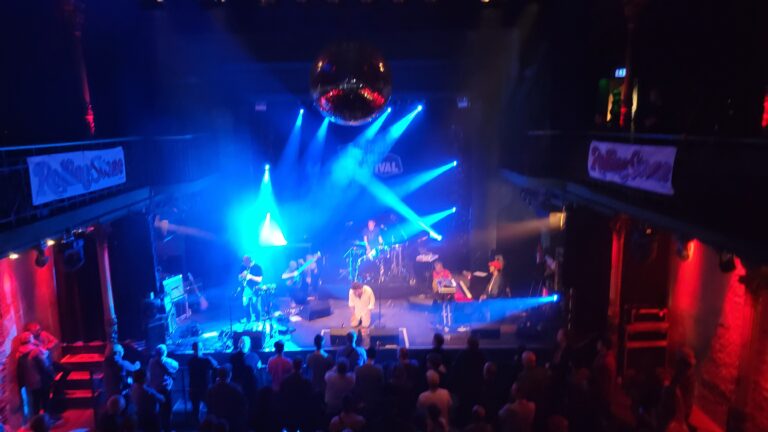
Starting promptly at 11:30 pm with strong bass and drums, the groove was no doubt excellent and the performance quite lively, but the catch was the lead singer Dan Bejar. Destroyer itself was a unique offering, with Bejar adding the flair that made this show well worth the recommendation. Performing in the vein of a freak poet, Bejar would take a knee after his portion of the song was complete, the band behind him carrying the tune to completion. Odd for the uninitiated (myself included), the music was at times feedback and a slow grinding for the audience, but they delighted in it nonetheless. Perhaps there is a Western Canadian appeal to the European crowd, or what this westerner presumes to be European influence on a Vancouver export, yet this remained a fantastic band to catch live and an otherwise great discovery.
Friday of Reeperbahn began a little late, as jetlag and exhaustion had finally caught up with me, and the beds at Premier Inn certainly not helping by being so inviting following a long day at school, followed by 12 hours of planes, trains and automobiles, then 6 hours of club-hopping. The German saying ‘Es ist nicht der Alkohol, der den Káter verursacht, sein Aufwachen” (it’s not the alcohol that causes the hangover, its waking up) never rang truer, and one that has always stuck with me since a trip to Bavaria and Austria in 2011. While no one pursues a hangover, travel, time change and revelry were quite the combo to contend with.
Venturing out into the bustling Spielbudenplatz, I found excellent Vietnamese at Com Nieu 21. While pho would have been a good option, a noodle salad and summer rolls with a Vietnamese iced coffee worked nicely to push through the aforementioned Káter. Taking a walk just a few minutes off the main drag, I found the city to be immediately quieter and residential, with kids playing, riding scooters and enjoying the day.

I walked down towards the Elbe River for a boat cruise and tour of the port area along with bloggers from Lithuania, Brazil and England. Drinking Astra beers and eating fried fish sandwiches fresh from the Elbe that day, the boat cruise was accentuated with great music and company amid canals reminiscent of Amsterdam, with twists and turns as we navigated the port. Spectacular views of the city and the Elbphilharmonie, where we would see a live performance that evening, gave a full scope view of the city to all.
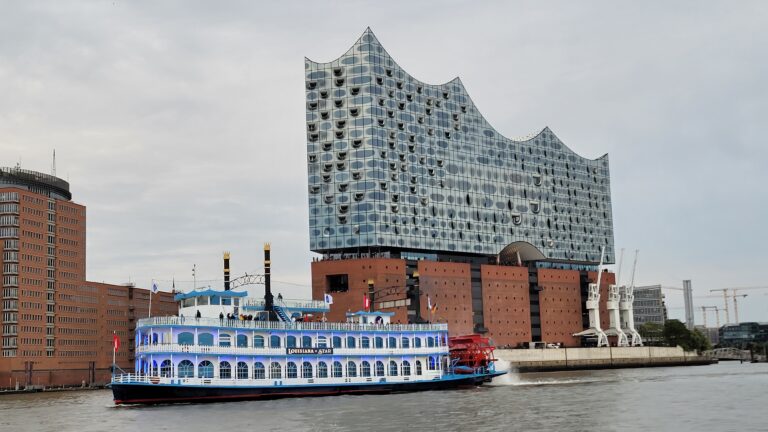
Disembarking at the Elbphilharmonie in HafenCity, and part of the Speicherstadt warehouse district (a UNESCO World Heritage site), we could see theaters for Der König Der Löwen (The Lion King) and Eiskönigin (Frozen) across the river, each of which had their own ferry for patrons. Hamburg is, after all, the third largest city in the world for musicals, with Hamilton having opened on October 6.
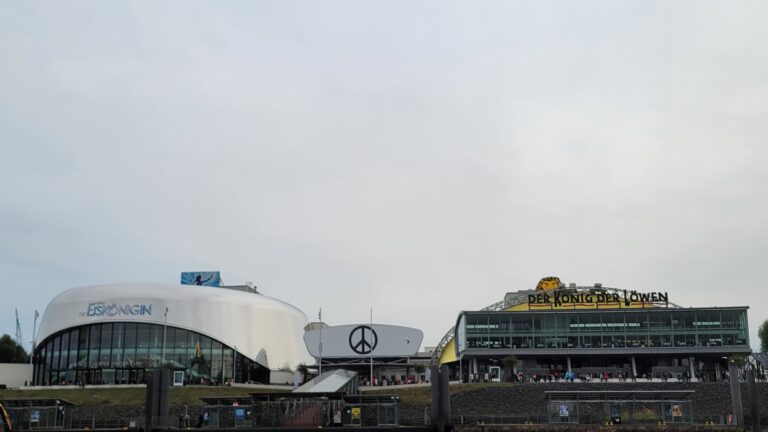
Located in the Kontorhaus business district with the Chilehaus, the Elbphilharmonie opened on January 11, 2017 and serves as a symbol of the city’s past, present and future. With an old warehouse serving as the foundation, when the Elbphilharmonie was constructed, supports were built into the river to ensure stability for this landmark on the Elbe River.
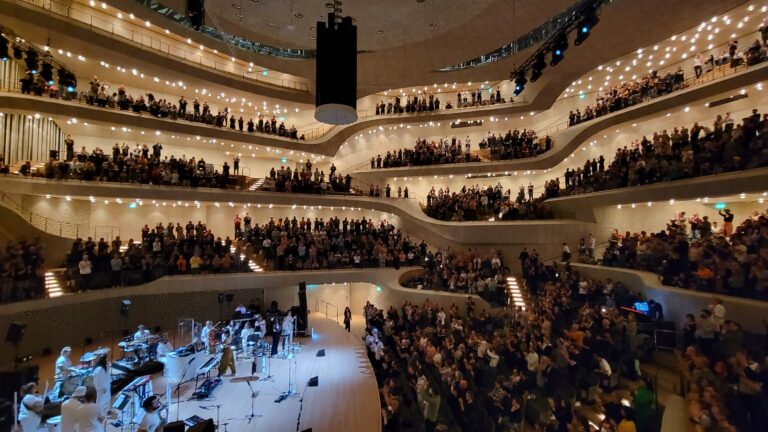
More than a concert venue, the building houses a Westin hotel, apartments, restaurants, conference rooms and a spa, plus the original cranes, all at a 866 Million Euro cost; while that price tag was controversial, the venue is a boon to the city and a must visit for anyone seeking acoustically perfect performance spaces. With the full concert hall having seating for 2100 created in a terraced manner so that no seat was more than 30 meters from the stage, the venue itself is decoupled from the rest of the building, ensuring that the sound is pristine with no outside interference.
Acoustics are so acute thanks to 10,000 individually shaped gypsum fiber panels, with a design for classical music in mind that ensures sound is distributed to each and every corner. What’s more, an organ was built inside the walls, and the stage location gives nearly a theater-in-the-round perspective to all in attendance.
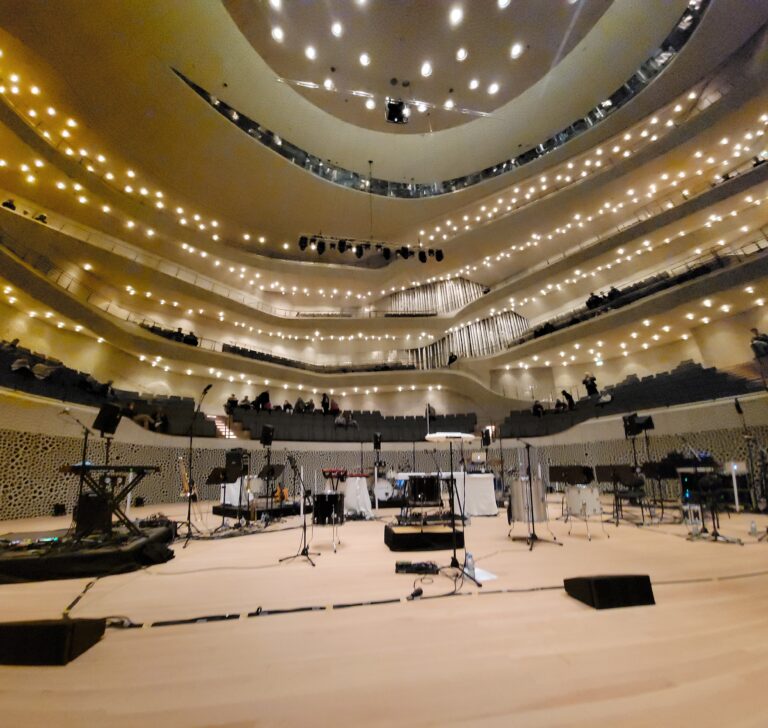
Taking a closeup look at the stage before a performance by Mine (Mee-na), I marveled at the arrangement of the seating, the proximity to the stage, and the music that we would be experiencing shortly. Taking a seat alongside Erik, a music critic from Copenhagen, this 75 minute performance, while entirely in German, stands out as one of the most spectacular of the festival, and the calendar year.
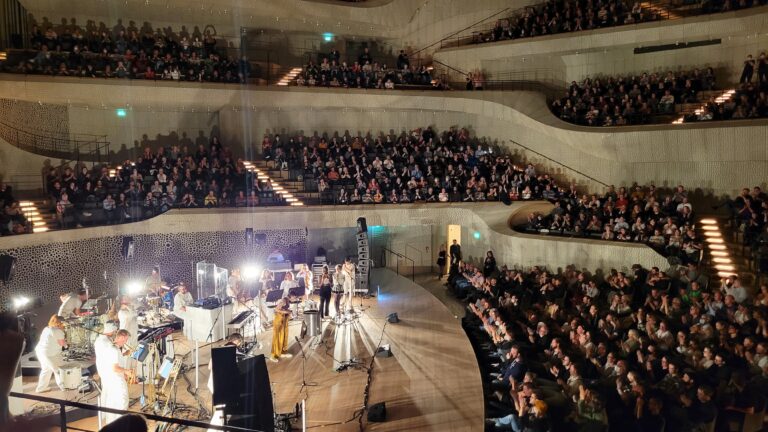
Entering the stage were a 13-piece band, including five strings, three backup singers and Mine, the lead singer who describes her music as “German-language folk with hip hop, jazz and electronic elements” arrived on stage and began a most symphonic performance. Joined by three additional drummers for the second song, not knowing German didn’t help, as Mine spoke to the audience between songs, with laughs and applause at times in a show that got more upbeat as it progressed.
Projections on the stage from overhead were mixed with lighting, with a South Asian flair added to each song via percussion, guitar and theremin. Joined by a New York letter jacket sporting Fatoni, whom Mine dueted with on “ROMCOM” in 2017, this James Corden lookalike (and thankfully not Corden) stayed for a few tunes to freestyle rap, eliciting approval from the audience.
Then the bagpipes began, with a piper coming in from the wings to crush the one song he was there to play. Mine continued into the performance, alternating between melodic solo songs and heavier full band engagements, bringing out a pink-haired vocalist for a song that drew huge applause, and establishing herself as the perfect artist to perform tonight in this monumental venue. A total of 21 musicians performed with Mine over the course of the show, and the audience gave a standing ovation the likes of which are rarely seen at American live music performances. Mine was a highlight of the weekend in a venue that is just as incredible as photos and videos show.


Comments are closed.